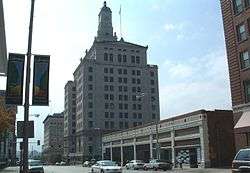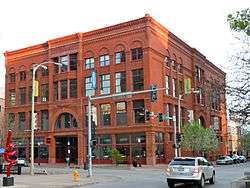Davenport Bank and Trust
|
Davenport Bank and Trust | |
 | |
  | |
| Location |
201-209 W. 3rd St. Davenport, Iowa |
|---|---|
| Coordinates | 41°31′20″N 90°34′33″W / 41.52222°N 90.57583°WCoordinates: 41°31′20″N 90°34′33″W / 41.52222°N 90.57583°W |
| Area | 1 acre (0.40 ha) |
| Built | 1927 |
| Architect | Weary and Alford |
| Architectural style | Classical Revival |
| MPS | Davenport MRA |
| NRHP Reference # |
83002395[1] (original) 16000249 (increase) |
| Significant dates | |
| Added to NRHP | July 7, 1983 |
| Boundary increase | May 12, 2016 |
Davenport Bank and Trust, also known as Davenport Bank Apartments, is a mixed-use facility located in Downtown Davenport, Iowa, United States. It was listed on the National Register of Historic Places in 1983 as American Commercial and Savings Bank. In 2016 the National Register approved a boundary increase with the Davenport Bank and Trust name.[2] The building houses commercial, office and residential space, and is the tallest building in the Quad Cities.
History
Henry Lischer and H.H. Anderson formed German Savings Bank in 1869 and by 1916 it was the largest bank in Iowa.[3] Because of anti-German sentiments that resulted from World War I the bank’s name was changed to American Commercial and Savings Bank.
In the 1920s, American Commercial and Savings Bank absorbed the Security Savings Bank. As a result of the Great Depression it absorbed Iowa National Bank, the Citizens Trust and Savings Bank, and the Farmers and Merchants Bank and was one of five banks in the city that was still active when President Franklin Roosevelt signed the Emergency Banking Act in 1933. The others included: Bechtel Trust Company, Northwest Davenport Savings Bank, Union Savings Bank and Trust, and Home Savings Bank.[4] It was one of only two banks to re-open in Davenport. The bank changed its name at this time to Davenport Bank and Trust Company under the direction of E.P. Adler. By 1936, it rebuilt itself to become the second largest bank in Iowa.[3]
V.O. Figge became associated with the bank in 1931 as a bank examiner and served as vice-president, president and CEO until it was sold to Norwest Bank in 1992.[5] It became Wells Fargo Bank after the merger of the two banks in November 1998.[6] In 2005 the building was purchased by Financial District Properties.[7] A $7.5 million renovation project in 2013 converted the building's fifth, ninth, tenth and eleventh floors into 29 market rate apartments.[8]
Wells Fargo Bank remained alongside other commercial and residential tenants until the weekend of April 23–24, 2016 when it moved its operations to the redeveloped Putnam-Parker Block.[9] The building was renamed Davenport Bank Apartments.[10]
Architecture
The building was designed by the Chicago architectural firm of Weary and Alford.[11] It was built by Walsh-Kahl Construction Company from 1926-1927.[12] The new building reflected the significance of the bank in the community. The main building is twelve stories with a steel frame faced with limestone.[7] The lower story façade contains an ornate metal entrance, columns with stylized capitals and recessed Roman arched windows. The rest of the building provides conventional office and residential space. The building is capped by a pedimented temple and a three-story-tall clock tower. Four 6-foot (1.8 m) statues of eagles sit at the corners of the tower. The cock faces are 10 feet (3.0 m) in diameter.[10] The total height of the building is 255 feet (78 m), which makes it the tallest building in the Quad City area.[13] A modern parking structure and additional space for the bank was built adjacent to the west side of the building in 1972.
The building has retained its original banking room, a multi-story space with an elaborately painted ceiling. The space is lit by the large Roman arched windows on the east elevation. The ceiling is a canopy of groin vaults and is painted in a multi-colored design. A painting by Davenport artist Hiram Thompsen depicting the signing of the treaty between the Sauk and Meskwaki tribes and the US government after the Black Hawk War has hung prominently on the south wall since 1928.[14] The original wrought iron teller “cages” remain and the rest of the interior features dark wood and marble elements.
Artwork
The ceiling decoration of the main banking room was designed by Chicago artist Alexander Rinoskopf and was executed by the Davenport decorating firm of Hartman and Sedding. Ten men created the stencils on 85 yards (78 m) of paper and two artists rendered the work in oils.[15] The Italian Renaissance style of work features spirals, rosettes, festoons, griffins, swans and masks. In addition there are also ten murals that are 6 feet (2 m) high, which provide a chronological history of Davenport from its earliest times to the American Civil War. The murals depict the arrival of the first Europeans to this part of the Mississippi River Valley (1654); the Sauk warrior Black Hawk (1812); the battle on Davenport's Credit Island in the War of 1812 (1814); the last bison chased from what is now the Quad Cities (1816); the construction of Fort Armstrong on what is now Arsenal Island (1817); the first steamboat up the Mississippi River (1823); the establishment of Davenport and immigration to the new town (1836); Davenport's first school (1838); the first railroad bridge across the Mississippi River (1856); and the Civil War training camps in that operated in Davenport (1861).
The largest mural occupies the south wall of the building and depicts the signing of the Black Hawk Treaty in September 1832. The treay was signed at what is now Fifth and Farnam Streets in Davenport.[15] Hiram Thompsen, who created the painting, was a native of Cincinnati and studied at the Chicago Art Institute and the Chicago Academy of Fine Arts. He was a commercial artist who went on to do advertising art work for Davenport-based Gordon-Van Tine and Montgomery Ward. The painting measures 15 by 9 feet (5 by 3 m).[15] It features the likenesses of General Winfield Scott, his interpreter and Davenport founder Antoine LeClaire, and the Native American chiefs Keokuk and Pashapaho.
Gallery
 1970s addition
1970s addition- Entrance detail
- Main Street elevation
- Third Street entrance
References
- ↑ National Park Service (2010-07-09). "National Register Information System". National Register of Historic Places. National Park Service.
- ↑ "National Register of Historic Places Program: Weekly List". National Register of Historic Places. Retrieved 2017-06-10.
- 1 2 Svendsen, Marlys A.; Bowers, Martha H. (1982). Davenport where the Mississippi runs west: A Survey of Davenport History & Architecture. Davenport, Iowa: City of Davenport. p. 5-4.
- ↑ Svendsen, 5-5.
- ↑ Wundram, Bill (July 18, 1995). "In tribute to 'Bubbles'". Quad-City Times. Davenport. Retrieved 2010-09-10.
- ↑ Gaul, Alma (January 26, 2014). "Bank building has storied past". Quad-City Times. Davenport. Retrieved 2014-03-28.
- 1 2 Neuses, Dawn (August 3, 2013). "Rooms with a view: Davenport landmarks being transformed". The Dispatch / The Rock Island Argus. Moline, Illinois. Retrieved 2013-08-26.
- ↑ Gaul, Alma (January 26, 2014). "Banking on it". Quad-City Times. Davenport. Retrieved 2014-03-28.
- ↑ DeWitt, Jennifer (April 25, 2016). "Wells Fargo leaves iconic bank building to become City Square anchor". Quad-City Times. Davenport. Retrieved 2016-04-25.
- 1 2 Ickes, Barb (June 10, 2017). "Off Limits Places: Tippy top of our tallest building". Quad-City Times. Davenport. Retrieved 2017-06-10.
- ↑ "Wells Fargo Building". Emporis. Retrieved 2012-01-09.
- ↑ "American Commercial and Savings Bank" (PDF). Davenport Public Library. Retrieved 2010-09-10.
- ↑ Treiber, Rachelle (January 4, 2002). "Tallest Buildings in Q-C". Quad-City Times. Davenport. Retrieved 2010-10-07.
- ↑ Federal Writers' Project of the Works Progress Administration for the State of Iowa (April 1959). Iowa: A Guide to the Hawkeye State. New York: Hastings House. p. 224.
- 1 2 3 Gaul, Alma (January 26, 2014). "Lobby ceiling is artistic, historic 'masterpiece'". Quad-City Times. Davenport. Retrieved 2014-03-28.
External links
| Wikimedia Commons has media related to Davenport Bank and Trust. |


